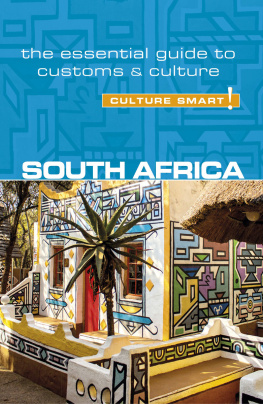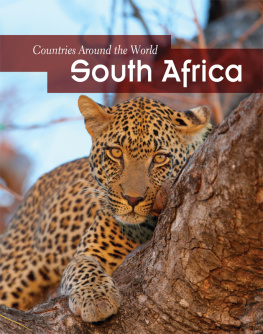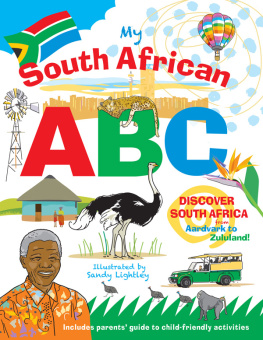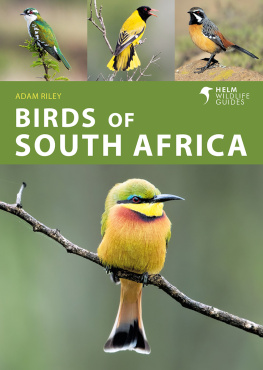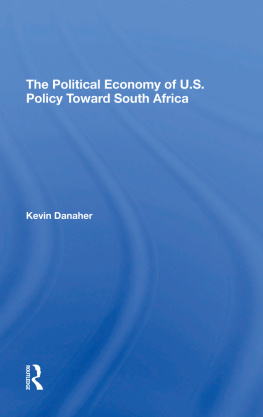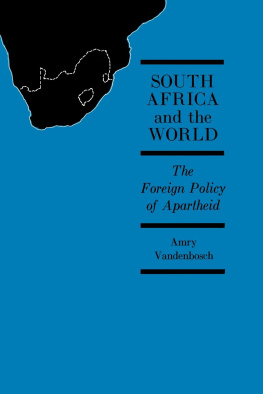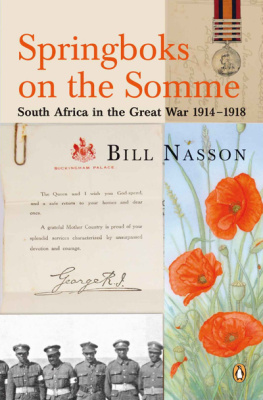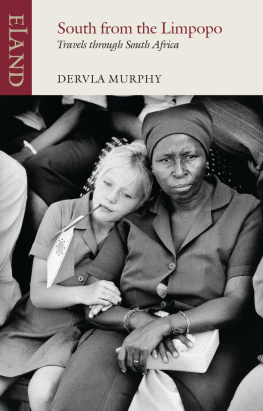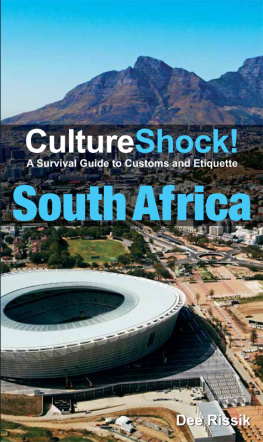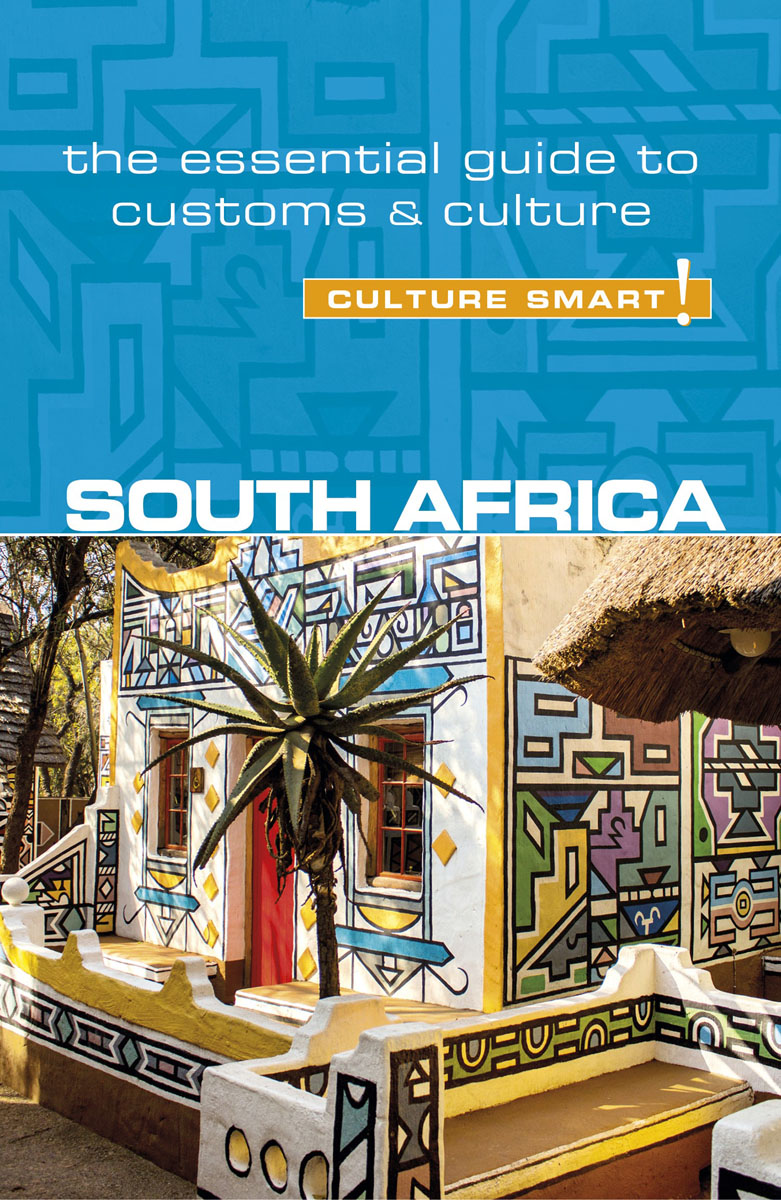
This book is available for special discounts for bulk purchases for sales promotions or premiums. Special editions, including personalized covers, excerpts of existing books, and corporate imprints, can be created in large quantities for special needs.
For more information contact Kuperard publishers at the address below.
ISBN 978 1 85733 872 0
British Library Cataloguing in Publication Data
A CIP catalogue entry for this book is available from the British Library
First published in Great Britain
by Kuperard, an imprint of Bravo Ltd
59 Hutton Grove, London N12 8DS
Tel: +44 (0) 20 8446 2440 Fax: +44 (0) 20 8446 2441
www.culturesmart.co.uk
Inquiries:
Series Editor Geoffrey Chesler
Design Bobby Birchall
Printed in Malaysia
Cover image: Traditional Ndebele painted house in Lesedi Cultural Village near Johannesburg. Shuttestock.com
Images on reproduced by permission of the South African Tourist Board.
Image on Shutterstock.com
Images on the following pages reproduced under Creative Commons Attribution-Share Alike 4.0 International license: No author given. Freddejager assumed.
Reproduced under Creative Commons Attribution-Share Alike 3.0 Unported license:19 AndyB; Marco Schmidt[1].
Creative Commons Attribution-Share Alike 2.0 Generic license: Jeff Attaway.
About the Author
ISABELLA MORRIS is an award-winning South African writer and journalist. After graduating from the University of the Witwatersrand with an M.A. in Creative Writing, she traveled extensively in Asia and Africa and contributed feature and travel articles to mainstream South African newspapers. During South Africas 2016 municipal elections she was campaign chief-of-staff to the current executive mayor of Johannesburg. Today Isabella is a writer and editor, and teaches travel writing, non-fiction, fiction, and short-story writing workshops. She lives in Johannesburg with her husband.
The Culture Smart! series is continuing to expand. All Culture Smart! guides are available as e-books, and many as audio books.
For latest titles visit
www.culturesmart.co.uk
The publishers would like to thank CultureSmart!Consulting for its help in researching and developing the concept for this series.
CultureSmart!Consulting creates tailor-made seminars and consultancy programs to meet a wide range of corporate, public-sector, and individual needs. Whether delivering courses on multicultural team building in the USA, preparing Chinese engineers for a posting in Europe, training call-center staff in India, or raising the awareness of police forces to the needs of diverse ethnic communities, it provides essential, practical, and powerful skills worldwide to an increasingly international workforce.
For details, visit www.culturesmartconsulting.com
CultureSmart!Consulting and CultureSmart! guides have both contributed to and featured regularly in the weekly travel program Fast Track on BBC World TV.
contents
Map of South Africa

introduction
How do I live in this strange place?
Bernoldus Niemand (alter ego of James Phillips, rock singer)
If South Africa had a DNA test, the diversity of the world would be found in its genetic coding. Since the first Australopithecus inhabited the region 2.5 million years ago, South Africa has been home to different groups moving across the landscape, and today is still home to people from across the globe, settling on its shores for economic, political, and social reasons, attracted as ever by the countrys bounty.
South Africa has eleven official languages, nine major black tribes, two major white groups, Asians, and Coloureds (the official designation for mixed-race people). It embraces all religions, has communists in its parliament, yet is a free market economy. There are the very rich and the very poor. Women sit in the cabinet, yet rural women are the least likely to have an education. So how indeed does one live in this strange place?
It is impossible to generalize about a people as diverse as the South Africans. Theyre not all good, and theyre not all bad. What they are is a nation of hope, where the majority want a future that seeks to embody what the writer Olive Schreiner called a great, healthy, harmonious, and desirable nation.
In spite of all the goodwill, South Africa has many problems, such as crime and HIV/AIDS, and in some instances the apparent loss of old values in favor of the new. Many traditions are being eroded by assimilation, languages such as Afrikaans are changing, and Kasi (a township language) is the lingua franca of black youth, many of whom no longer speak their native languages.
South Africa is an in-between land. It stands on the cusp of the old and the new, the First and the Third Worlds, the North and the South. This book will introduce you to a vibrant society in transition. It examines the often painful past to explain some of the complexities and contradictions of modern South African society. It looks at how people relate to each other, at home, work, and play, and offers advice on what to expect and how to behave in different situations. South Africans are big-hearted and optimistic. Make the effort to understand them, and they will welcome you unreservedly.
South Africa has been variously described as a country with a heartbeat as strong as a jackhammer, Gods armpit, an intellectual dorp (village), and a pioneering nation, but political commentator Rian Malan probably puts it best: This is South Africa, where nothing can be taken for granted, even if you see it with your own eyes.
Key Facts
Official Name | The Republic of South Africa |
Capital Cities | Tshwane (formerly Pretoria), administrative capital; Cape Town, legislative capital; Bloemfontein, judicial capital |
Cities of the Major Metropolitan Municipalities (population estimates based on 2011 figures) | Buffalo City (East London, pop. 478,600); City of Cape Town (pop. 3.4m); City of Johannesburg (pop. incl. Soweto 3.7m); City of Tshwane (Pretoria pop. 1.6m); Ekurhuleni (East Rand, pop. 3.2m); eThekwini (Durban, pop. 3.4m); Mangaung (Bloemfontein, pop. 747,400); Nelson Mandela Bay (Port Elizabeth, pop. 967,600) |
Area | 470,693 square miles (1,219,090 sq. km) |
Climate | Semidesert to subtropical, but largely moderate. The southwestern Cape has a Mediterranean-type climate. |
Population | 55,908 900 (2016) |
Ethnic Makeup | Black 45,109,900; Coloured 4,897,200; White 4,515,800; Indian/Asian 1,386,000 |
Language | There are 11 official languages. While Afrikaans is the most widely spoken, English is the dominant commercial language. | Language speakers as % of total (2011): Afrikaans 13.5%; English 9.6%; isiNdebele 2.1%; isiXhosa 16%; isiZulu 22.7%; Sepedi 9.1%; Sesotho 7.6%; Setswana 8%; SiSwati 2.5%; Tshivenda 2.4%; Xitsonga 4.5%; Other 2% |

